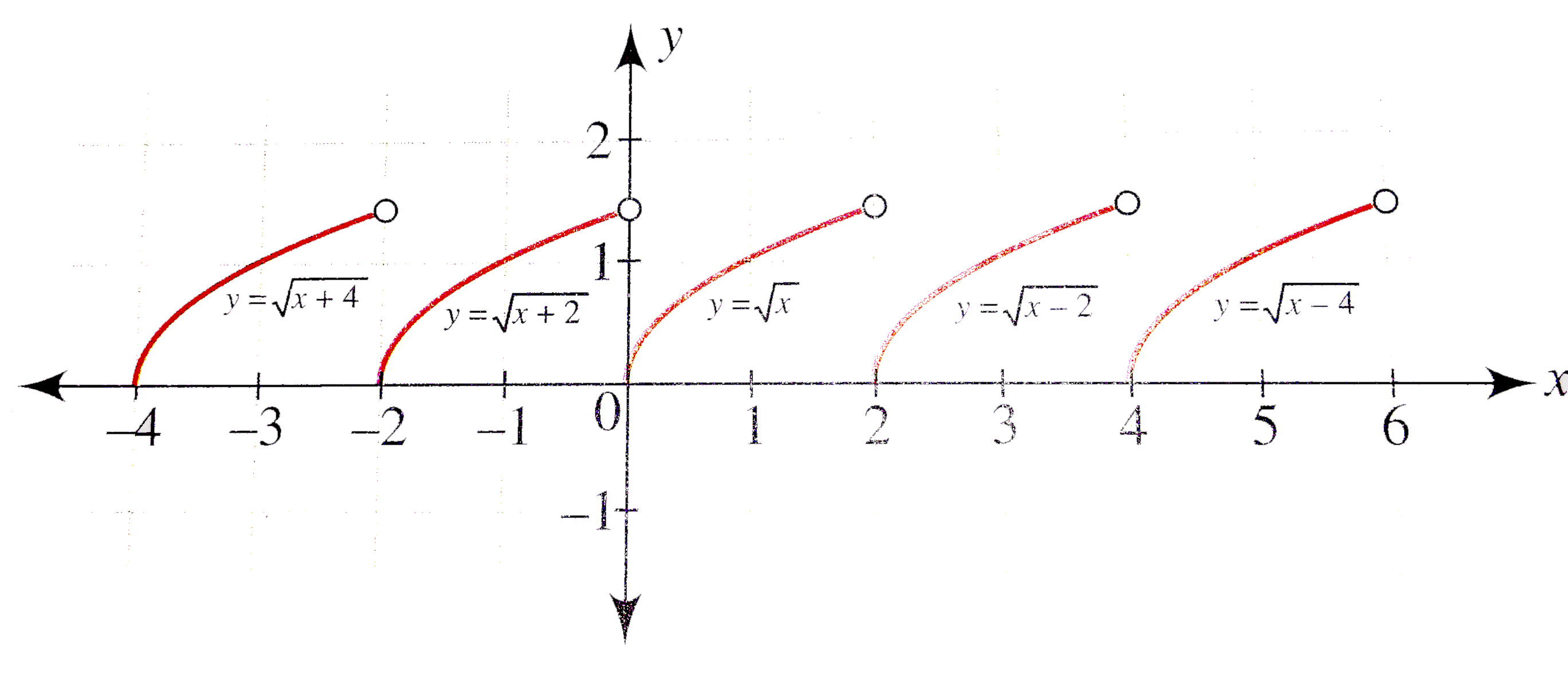Let g(x)=√x−2k,∀2k≤x<2(k+1), where k∈ integer. Check whether g(x) is periodic or not.Solution in Bengali
g(x)=√x−2k∀2k≤x<2(k+1) , where k is an integer.
⇒ g(x)=⎧⎪
⎪
⎪
⎪
⎪
⎪
⎪
⎪
⎪
⎪
⎪
⎪
⎪
⎪
⎪
⎪⎨⎪
⎪
⎪
⎪
⎪
⎪
⎪
⎪
⎪
⎪
⎪
⎪
⎪
⎪
⎪
⎪⎩............√x+2,−2≤x<0√x,0≤x<2√x−2,2≤x<4√x−4,4≤x<6............
Function in each branch is part of parabolas lying above x-axis.
Graph of the function is as shown in the following figure.

From the graph y=g(x) is periodic with period 2.
Topper's Solved these Questions
- BOOK - CENGAGE PUBLICATIONCHAPTER - GRAPHS OF ELEMENTARY FUNCTIONS EXERCISE - EXERCISES34videos
GRAPHS OF ELEMENTARY FUNCTIONS
- BOOK - CENGAGE PUBLICATIONCHAPTER - GRAPHS OF POLYNOMIAL AND RATIONAL FUNCTIONSEXERCISE - Exercises17videos
GRAPHS OF POLYNOMIAL AND RATIONAL FUNCTIONS
- BOOK - CENGAGE PUBLICATIONCHAPTER - GRAPHS OF TRIGONOMETRIC FUNCTIONSEXERCISE - Exercises22videos
GRAPHS OF TRIGONOMETRIC FUNCTIONS
Similar Questions
Draw the graph of y=1(1/x).
04:38View SolutionDraw the graph of y=(x−1)(x2−x+1).
04:04View SolutionDraw the graph of y= cosec 2x−cot2x. Is f(x) periodic ? If yes, what is its fundamental period ?
04:21View SolutionLet g(x)=√x−2k,∀2k≤x<2(k+1), where k∈ integer. Check whether g(x) is periodic or not.
02:14View Solutionf(x)=(cos^(2)x)/(1+cos x+cos^(2)x) and g(x)=k tan x+(1-k)sin x-x, where k in R,g'(x)=
01:35View SolutionLet f(x)=(log x)/(x), and solution of f(x)=k be denoted by g(k). {where k<0}g:(-oo,0)rarr(0,1), then y=g(x) will be
02:52View SolutionLet a function f be even and integrable everywhere and periodic with period 2. Let g(x)=∫x0f(t)dt and g(t)=kThe value of g(2) in terms of k is equal to (A) k (B) 2k (C) 3k (D) 5k
View SolutionCheck whether following pairs of function are identical or not?
f(x)=√x2 and g(x)=(√x)204:40View SolutionLet g(x)=√x−2k,∀2k≤x<2(k+1) where, k∈l , then
03:55View SolutionColumn -1( Reaction Equilibrium ) Column -II ( Degree of dissociation of X in terms of their equilibrium constants assuming degree of dissociation of Y is same that of X whenever applicable ) ( P ) X ( g) rarr Z (g) + Y ( s) ( 1) ( 2 sqrt( K))/( 1+ 2 sqrt(K)) ( Q ) 2X(g) rarr Y (g) + Z ( g) ( 2) ( 2 sqrt( K))/( 1+ sqrt(K)) ( R ) X ( g) +Y(g) rarr Z(g) + W(g) ( 3) ( K )/( K +1) ( S ) X ( g) rarr ( Y )/( 2)(s) + ( Z)/( 2) (g) ( 4) ( 2K)/( 1+ 2K) Codes :
04:52View Solutionϕ(x)=f(x)⋅g(x)andf'(x)⋅g'(x)=k ,then 2kf(x)⋅g(x)=
02:52View SolutionLet g be a function defined by g(x)=√{x}+√1−{x} .where {.} is fractional part function, then g is
05:02View SolutionLet g(x)=√x−2k,∀2k≤x<2(k+1), where k∈ integer. Check whether g(x) is periodic or not.
02:48View SolutionLet g(x)=√x−2K,∀2K≤x<2(k+1), wherek∈ integer . If g(x) is periodic then period of g(x) is
02:33View Solutionϕ(x)=f(x)g(x)andf'(x)g'(x)=k, then 2kf(x)g(x) =
01:16View SolutionCheck whether following pairs of function are identical or not?
f(x)=√x2 and g(x)=(√x)204:14View Solution
